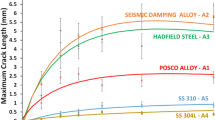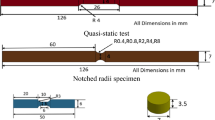Abstract
Fracture toughness of pre-strain effect was determined as a function of the temperature in structural steels of the 600 to 780 MPa class. Cyclic loading during earthquakes produces pre-strain in the component, which is enhanced at the region of strain concentration. During the Kobe Great Earthquake in 1995 in Japan, 10 to 15 % pre-strain was recorded at the beam-to-column connection. The relationship between critical CTOD and CGHAZ length was sampled by fatigue pre-crack for pre-strained HAZ, which is a significant decrease compared to that of the base metal. Furthermore, the effect of pre-strain is discussed in terms of the CTOD and Charpy impact energy of the local brittle zone.
Similar content being viewed by others
References
K. Masubuchi, Analysis of welded structures-fracture toughness, 1st edition, Pergamon, New York (1980) 336–399.
Y. Yamaguchi and T. Matsumoto, Technical requirements to ensure structural reliability for mega container shipsapplication of new higher strength hull structure steel plates of heavy thickness, Design & Operation of Container Ships, UK (2006) 43–50.
Y. Nakano, Fracture toughness of steels (?) fracture tough-ness and its control factors, Quarterly J. of the Japan Welding Society (1992) 6–13 (Japanese).
B. Bezensek and J. W. Hancock, The toughness of laser welded joints in the ductile–brittle transition, Engineering Fracture Mechanics, 74 (2007) 2395–2419.
M. Hajjaj, C. Berdin, P. Bompard and S. Bugat, Analyses of cleavage crack arrest experiments: influence of specimen vibration, Welding Research (1992) 65–73.
E. J. Ripling and P. B. Crosley, Crack arrest fracture toughness of a structural steel (A36), Engineering Fracture Mechanics, 75 (2008) 2984–3009.
AIJ. Steel Committee of Kinki Branch, Reconnaissance report on damage of steel structgure observed from the 1995 Hyogoken-Nanbu(Hanshi/Awaji) earthquake (1995).
M. Toyoda, How steel structures fared in Japan great earthquake, Welding Journal, 74 (1995) 132–136.
E. Hemmericha, B. Rolfeb, P. Hodgsona and M. Weissa, The effect of pre-strain on the material behaviour and the bauschinger effect in the bending of hot rolled and aged steel, Materials Science and Engineerin, 528 (2001) 3302–3309.
A. J. Robinson and S. Tetelman, The relationship between crack tip opening displacement, local strain and specimen geometry, International Journal of Fracture, 11 (1975) 453–468.
WES 2808, Method of assessing brittle fracture in steel weldments subjected to large cyclic and dynamic strain, The Japan Welding Engineering Society (2008).
K. Anami and C. Miki, Fatigue strength of welded joints made of high-strength steels, Fatigue and Fracture, 3 (2001) 86–94.
BS 7448 Part 1, Fracture mechanics toughness tests: Method for determination of KIc, Critical CTOD and Critical J Values of Metallic Materials, BSI (1999).
S. Suzuki, K, Bessyo, M. Toyoda and F. Minami, Property distribution map to understand HAZ CTOD toughness, Proceedings of the 12th International Conference on Offshore Mechanics and Arctic Engineering (OMAE), Glasgow, 3B (1993) 753–760.
T. Shiwaku, Y. Kobayashi, M. Shimizu, M. Toyoda and F. Minami, Metallurgical factors on toughness in intercritically reheated HAZ of low-C low-alloy steel, Proceedings of the 4th International Offshore and Polar Engineering Conference, Kobe (1994) 215–221.
Y. Nakao, H. Oshige and S. Noi, Distribution of microstructures and toughness in HAZ of multi-pass welded high strength steel, Proceedings of the 4th International Symposium, Japan Welding Society (1985) 503–508.
H. Zhou and Z. Liu, Heat conduction analysis of heterogeneous objects based on multi-color distance field, Material & Design, 31 (7) (2010) 3331–3338.
A. Hohenwarter, C. Kammerhofer and R. Pippan, The ductile to brittle transition of ultrafine-grained Armco iron: An experimental study, Journal of Material Science, 41 (17) (2010) 4805–4812.
T. Inoue and Y. Kimura, Effect of initial notch orientation on fracture toughness in fail-safe steel, J. of Material Science, 48 (13) (2013) 4766–4772.
Author information
Authors and Affiliations
Corresponding author
Additional information
Recommended by Associate Editor Hak-Sung Kim
Gyubaek An received his Ph.D. degree Department of Manufacturing Science Osaka University in Japanm 2001. He is an Assistant Professor at Department of Naval Architecture & Ocean Engineering, Chosun University, Republic of Korea.
Rights and permissions
About this article
Cite this article
An, G., Park, JU., Ohata, M. et al. Pre-strain effect of on fracture performance of high-strength steel welds. J Mech Sci Technol 32, 3145–3151 (2018). https://doi.org/10.1007/s12206-018-0617-7
Received:
Revised:
Accepted:
Published:
Issue Date:
DOI: https://doi.org/10.1007/s12206-018-0617-7




